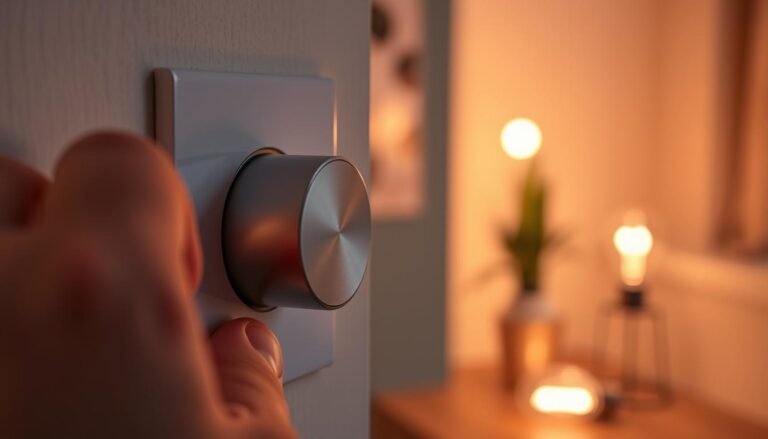Affiliate Disclosure: This post may contain affiliate links. If you make a purchase, we may earn a small commission at no extra cost to you.
When it comes to measuring brightness, you may have come across the terms lux and lumens. While they are related to each other, they actually measure different aspects of light.
Understanding the difference of lux vs lumens can help you make informed decisions when it comes to selecting lighting solutions or evaluating lighting performance.

Let us help you find great lighting choices that fit your needs and style
Key Takeaways:
- Lux measures illuminance, which is the total amount of light that falls on a surface.
- Lumens measure luminous flux, which is the total amount of light emitted in all directions by a light source.
- Lux is measured in lumens per square meter, while lumens measure the total brightness of a light source.
- When comparing lux ratings, consider the distance at which the measurement was taken, as lux decreases with distance from the light source.
- Lux is commonly used to determine the brightness of a surface, while lumens are used to compare the total light output of different light sources.

Lux vs Lumens in Practical Applications
In practical applications, understanding the concept of lux vs lumens plays a crucial role in achieving optimal lighting conditions. Lux levels, which refer to the brightness perceived by a surface, are essential for different tasks and environments. On the other hand, lumens enable us to determine the total light output of a single light source.
Also Read – Lumens vs Watts: Light Output Explained
Let’s explore lux levels in more detail. Lux measurement is used to quantify the amount of light that falls on a surface. It is particularly important when assessing the brightness required for specific activities or locations.
For example, a dark, cloudy day might have a lux level of 1,000, while direct daylight can reach lux levels of 100,000.
In indoor spaces, lux levels can vary based on the lighting fixtures used. Different applications may demand varying lux levels to ensure the desired lighting conditions are met.

For instance, a workspace may require higher lux levels to enhance productivity and visual clarity, while a relaxation area might benefit from lower lux levels to create a more soothing ambiance.
Now, let’s shift our focus to lumens and their significance. Lumen output is used to measure the total amount of light emitted by a light source, such as a bulb or LED. It provides valuable information about the brightness of a light source and enables easy comparison between different sources.
Each light source has a specific lumen output, which can be measured using specialized instruments. Several factors influence the lumen output, including the type of bulb or LED chip used. By considering lumen output, you can select the appropriate light source for your specific lighting needs.
To further illustrate the practical application of lux levels and lumen output, let’s visualize some examples:
| Environment | Lux Levels | Application |
|---|---|---|
| Office workspace | 500 – 750 lux | Enhanced productivity and visual clarity |
| Art gallery | 150 – 300 lux | Highlighting artwork while maintaining an intimate atmosphere |
| Retail store | 750 – 1000 lux | Ensuring product visibility and appealing shopping experience |
In conclusion, understanding lux levels and lumen output is crucial for achieving optimal lighting conditions. By considering lux levels, you can ensure that the desired brightness is achieved for various tasks and environments. On the other hand, assessing lumen output enables you to select the most suitable light source to meet your specific lighting needs.
By combining both lux levels and lumen output knowledge, you can make informed decisions when designing lighting solutions.
Lux vs Lumens in Lighting Design
When designing lighting installations, it is crucial to take into account the measurement of lux vs lumens. Lux, which refers to the amount of illuminance on a surface, can be measured using handheld light meters or spectrometers.
On the other hand, lumens indicate the total light output of a light source and require more specialized instruments such as goniospheres or integrating spheres.
During the design process, lux calculations play a vital role in determining the appropriate amount of light needed for a particular area. By considering the square meterage and the desired lux level for that space, you can ensure optimal lighting conditions.

Additionally, it is important to take into account the light output ratio (LOR) of the light fittings. The LOR determines the actual total illumination levels provided by the fittings, allowing you to make informed decisions about the number and placement of the light sources.
Furthermore, when designing lighting installations, it is crucial to consider lumen depreciation. Light sources gradually lose their light output over time, which can affect the desired lux levels. To maintain consistent illumination, it may be necessary to adjust the number of light fittings or replace them as needed throughout the lifetime of the light sources.
Overall, a thorough understanding of both lux vs lumens is essential in creating optimal lighting designs. By measuring lux and lumens accurately, calculating lux levels, considering the light output ratio, and accounting for lumen depreciation, you can ensure that your lighting installations provide the desired illumination levels and meet the needs of the space.
Lux to Lumens Conversion
For the lux to lumens conversion, you need to know two things: the brightness of the light source (in lumens) and the distance between the light source and the surface you’re measuring (in meters).
Here’s the formula for converting lumens to lux:
lux = lumens / (distance * distance)
For example, if you have a light source that emits 1000 lumens and it’s 2 meters away from the surface you’re measuring, the lux would be:
lux = 1000 lumens / (2 meter * 2 meter)
lux = 1000 lumens / 4 square meter
lux = 250
Conversely, here’s the formula for converting lux to lumens:
lumens = lux * (distance * distance)
So, if you know the illuminance of a surface in lux and the distance from the light source to that surface in meters, you can calculate the number of lumens required to achieve that illuminance.
For example, if you want to achieve an illuminance of 500 lux on a surface that’s 4 meters from the light source, you would need a light source with a lumen output of:
lumens = 500 lux * (4 meters * 4 meters)
lumens = 500 lux * 16 square meters
lumens = 8000
As you can see, the difference between lux vs lumens is important to understand when choosing lighting for a space. Be sure to consider the task at hand and the desired effect before selecting a light source.
It should be noted that this formula for the lux to lumens conversion is only an approximation, and the actual number of lumens may be different. However, it is a good starting point for those who are looking to convert lux to lumens.
Visit our FREE Lighting calculator to obtain a more accurate result according to your needs
FAQ
What is the difference between lux vs lumens?
Lux is a measure of illuminance, which refers to the total amount of light that falls on a surface. Lumens, on the other hand, is a measure of luminous flux, which is the total amount of light emitted in all directions.
How are lux levels and lumens used in practical applications?
Lux levels are used to determine the brightness of a surface, such as reading material or photography subjects. Lumens, on the other hand, are used to compare the total light output of different light sources.
What factors should be considered when designing lighting installations?
When designing lighting installations, it is important to consider factors such as the desired lux level, the area that needs to be illuminated, the light output ratio (LOR) of the light fitting, and the lumen depreciation of the light source.

Let us help you find great lighting choices that fit your needs and style
Check out our FREE Calculators on our Resources Page
Source Links
- https://www.waveformlighting.com/home-residential/what-is-the-difference-between-lux-and-lumens
- https://greenbusinesslight.com/resources/lighting-lux-lumens-watts/
- https://www.candlepowerforums.com/threads/lux-vs-lumens.25030/








